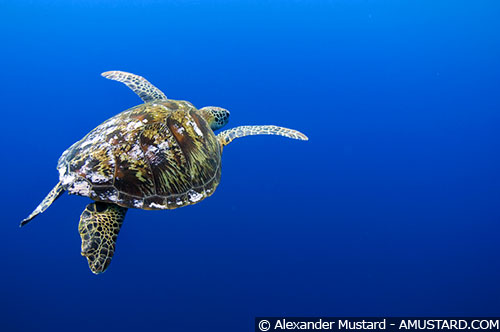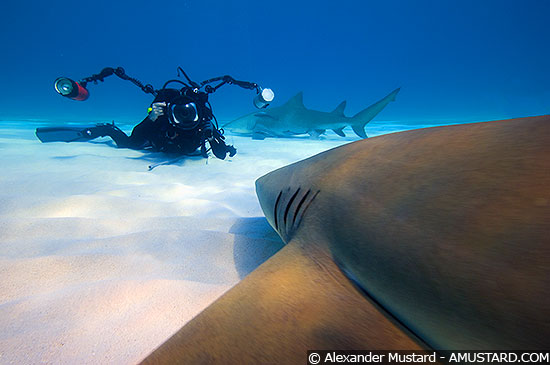Photographing with
filters underwater
If you want to get good results with the Magic filter we strongly recommend you have a look through this section.
Ambient light photography requires a different approach to shooting with strobes. To produce even lighting on the subject it is important to shoot WITH the natural light.
Position yourself so that the light comes from behind you and fully illuminates the subject. But take care that your own shadow is not cast on the subject! A slightly downward camera angle can be very effective at ensuring even lighting and helps produce a pleasing blue water colour. The wider the angle of coverage of your lens the more a downward camera angle helps. Also try and hold the camera as steady as possible to ensure a sharp photo and with newer cameras you should increase the ISO a little.

The slightly downward camera angle used here produces even lighting on the corals
and helps darked the blue of the water (ŠAM). Bali - original Magic.
Lens choice is also important. For DSLR users a 180 degree fisheye is the best choice for wreck shots and in low viz, but for general reef shooting, schooling fish etc, both Peter and prefer using a 15/16mm fisheye on our Nikon DSLRs. The Nikon 16mm, Sigma 15mm or Canon 15mm, when used on cropped sensor cameras (e.g. ), are probably the best lenses for filter photography. Of course, with a Tokina 10-17mm you have this and more. Rectilinear wide angle zooms are also good, as long as you have a good dome port/dioptre setup. The Magic filter is also worth trying with longer lenses and both of us have made several dives using filters on 17-55mm and 28-70mm lenses.
The video exert from the Shooting Magic instructional DVD shows some of the techniques of shooting with filters.
Lens choice for compact users is more restrictive - although you usually have the ability to change them during a dive. As a general rule wide angle accessory lenses make a big difference to filter shots. But it is still possible to get great images with the standard lens, although it it important to select your subject carefully.
Ambient light images tend to lack contrast compared to strobe lit shots so try to isolate your subject against open water so that it does not disappear into the background.

Isolating the turtle against open water helps produce a stronger image. Sipadan - original Magic.
Automatic metering usually does a very good job with ambient light images. Shutter speed priority Auto (set to between 1/60th & 1/125th) can be useful for stopping blur on moving subjects.
Check your histogram to be certain of a good exposure. Sometimes filter shots benefit from a little underexposure, while occasionally a slight over exposure can help.
All filters work by the subtraction of light. Seawater subtracts the red/orange/yellow wavelengths from light as it passes through, and then the filter acts to subtract the blue light to rebalance the spectrum. With all this subtraction going on filters work best in bright conditions. Shoot filters on sunny days, in calm, clear and shallow waters for the best results.
You may also want to increase the sensitivity say to ISO 200 or 400. If you have a camera with good high ISO performance then you can increase this further still.
One of the biggest advantages of filters is that they allow you to create photographs with great colour penetrating much deeper into the image than flash lit shots. There are many compositions that will allow you to exploit this to create types of images that you never have before.

This image shows a Lemon Shark swimming towards a photographer (James Wiseman). Because I was using a filter
I was able to get colour both on the foreground and the background. Bahamas - orginal Magic.
If you want to get good results with the Magic filter we strongly recommend you have a look through this section.
Ambient light photography requires a different approach to shooting with strobes. To produce even lighting on the subject it is important to shoot WITH the natural light.
Position yourself so that the light comes from behind you and fully illuminates the subject. But take care that your own shadow is not cast on the subject! A slightly downward camera angle can be very effective at ensuring even lighting and helps produce a pleasing blue water colour. The wider the angle of coverage of your lens the more a downward camera angle helps. Also try and hold the camera as steady as possible to ensure a sharp photo and with newer cameras you should increase the ISO a little.

The slightly downward camera angle used here produces even lighting on the corals
and helps darked the blue of the water (ŠAM). Bali - original Magic.
Lens choice is also important. For DSLR users a 180 degree fisheye is the best choice for wreck shots and in low viz, but for general reef shooting, schooling fish etc, both Peter and prefer using a 15/16mm fisheye on our Nikon DSLRs. The Nikon 16mm, Sigma 15mm or Canon 15mm, when used on cropped sensor cameras (e.g. ), are probably the best lenses for filter photography. Of course, with a Tokina 10-17mm you have this and more. Rectilinear wide angle zooms are also good, as long as you have a good dome port/dioptre setup. The Magic filter is also worth trying with longer lenses and both of us have made several dives using filters on 17-55mm and 28-70mm lenses.
 Fisheyes are best for wrecks. Nikon D2X + 10.5mm. |
 Cropped fisheyes are ideal on reefs. Nikon D2X + 16mm. |
 Wide angle zooms offer versatility. Nikon D2X + 12-24mm |
 Longer lenses can produce interesting images. Nikon D2X + 28-70mm |
The video exert from the Shooting Magic instructional DVD shows some of the techniques of shooting with filters.
|
|
Lens choice for compact users is more restrictive - although you usually have the ability to change them during a dive. As a general rule wide angle accessory lenses make a big difference to filter shots. But it is still possible to get great images with the standard lens, although it it important to select your subject carefully.
 Accessory wide angle lenses are best with compacts. |
 But the standard lenses can also produce nice images. |
Ambient light images tend to lack contrast compared to strobe lit shots so try to isolate your subject against open water so that it does not disappear into the background.

Isolating the turtle against open water helps produce a stronger image. Sipadan - original Magic.
Automatic metering usually does a very good job with ambient light images. Shutter speed priority Auto (set to between 1/60th & 1/125th) can be useful for stopping blur on moving subjects.
Check your histogram to be certain of a good exposure. Sometimes filter shots benefit from a little underexposure, while occasionally a slight over exposure can help.
All filters work by the subtraction of light. Seawater subtracts the red/orange/yellow wavelengths from light as it passes through, and then the filter acts to subtract the blue light to rebalance the spectrum. With all this subtraction going on filters work best in bright conditions. Shoot filters on sunny days, in calm, clear and shallow waters for the best results.
You may also want to increase the sensitivity say to ISO 200 or 400. If you have a camera with good high ISO performance then you can increase this further still.
One of the biggest advantages of filters is that they allow you to create photographs with great colour penetrating much deeper into the image than flash lit shots. There are many compositions that will allow you to exploit this to create types of images that you never have before.

This image shows a Lemon Shark swimming towards a photographer (James Wiseman). Because I was using a filter
I was able to get colour both on the foreground and the background. Bahamas - orginal Magic.